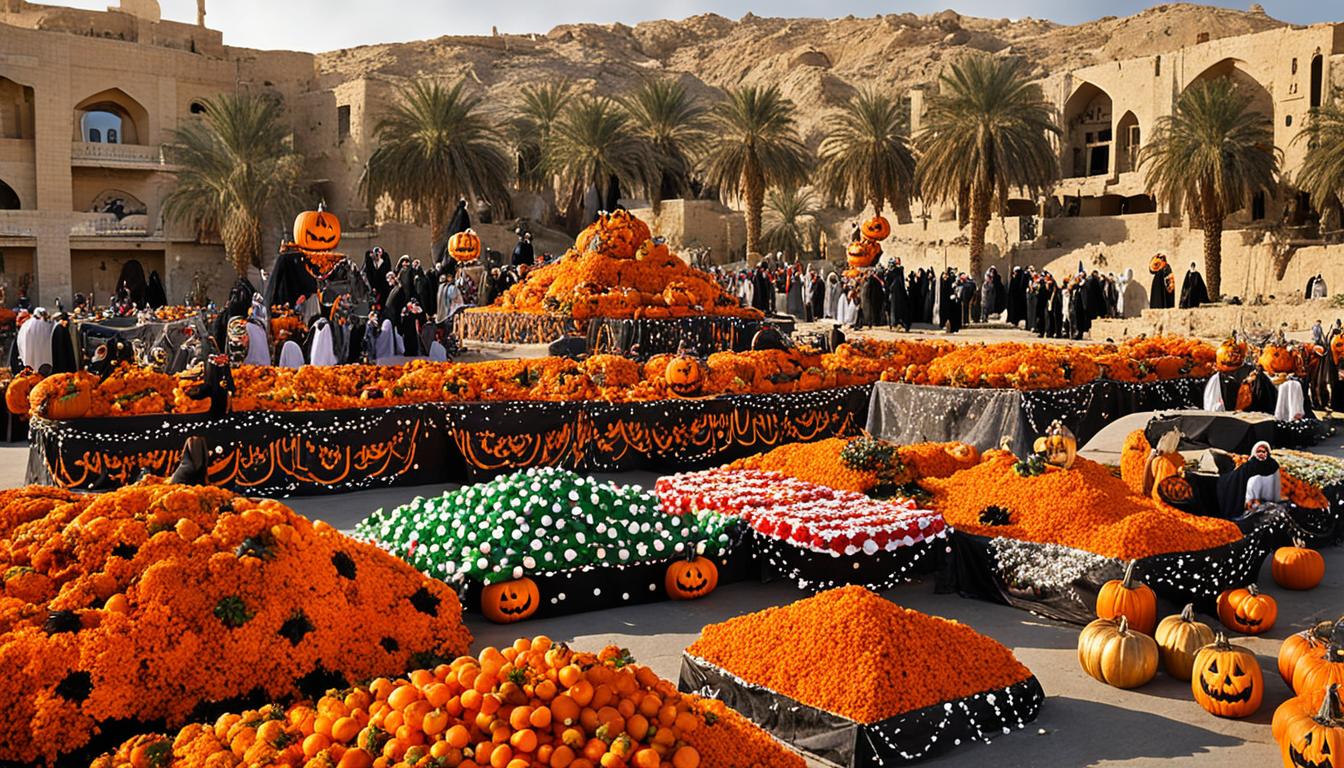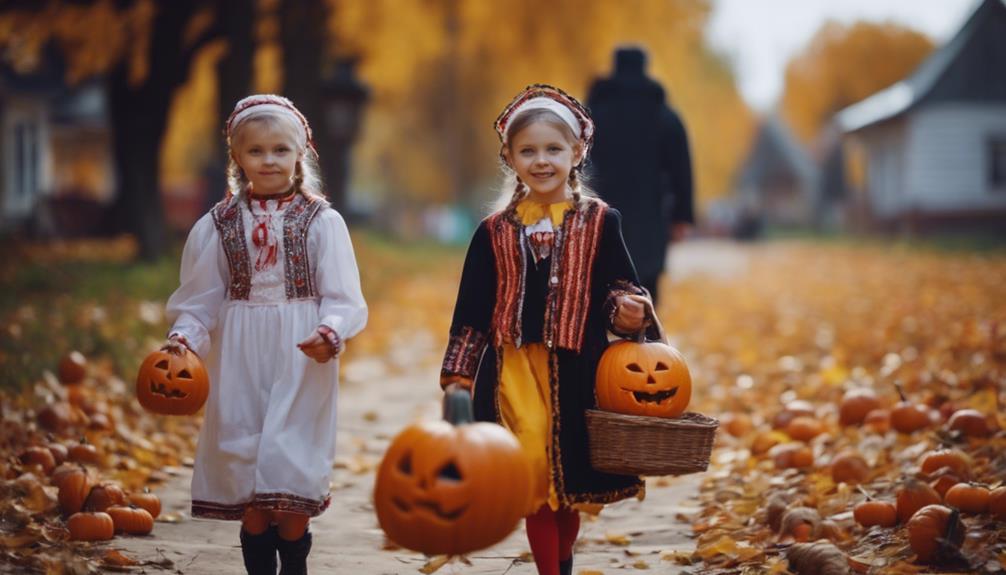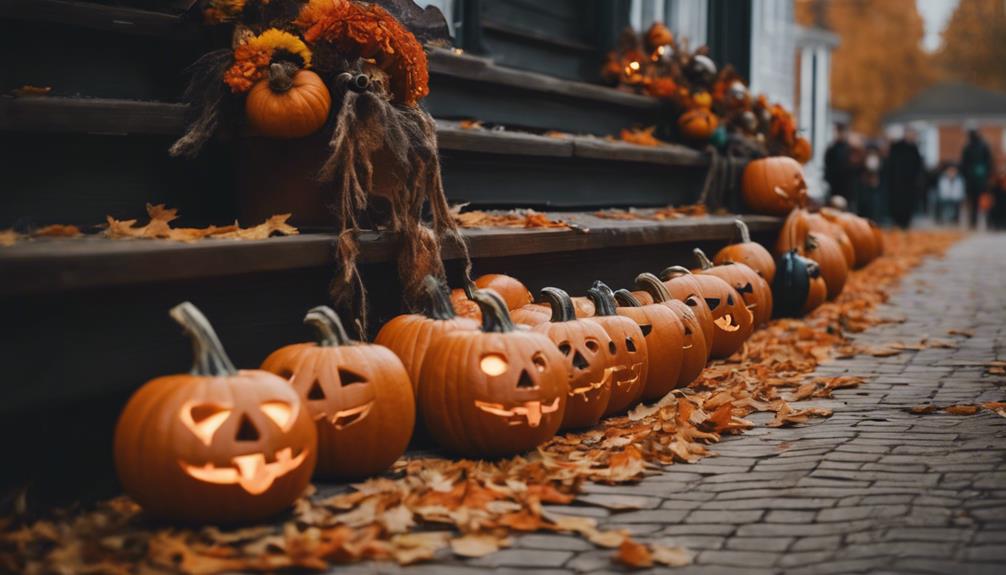Did you know that Estonia, a country known for its unique culture and traditions, does not traditionally celebrate Halloween? Instead, Estonians have their own holiday called All Souls’ Day or Hingedepäev, which holds a special place in their hearts. It is a solemn day dedicated to honoring the departed loved ones.
On All Souls’ Day, Estonians show their respect by placing candles in windows or on graves. This heartfelt tradition creates a serene and beautiful glow in cemeteries, as families come together to remember and pay homage to their ancestors.
Although Halloween customs have made their way to Estonia, they are more commonly observed in bars and clubs with Halloween-themed events and costume parties. It is in these social settings that Estonians have embraced the fun and light-hearted side of Halloween while preserving their own deeply-rooted customs.
Key Takeaways:
- Estonia does not traditionally celebrate Halloween.
- All Souls’ Day or Hingedepäev is a solemn day in Estonia to honor the dead.
- Estonians place candles in windows or on graves to remember departed loved ones.
- Halloween customs are more commonly observed in bars and clubs in Estonia.
- Estonia embraces its own unique traditions while incorporating elements of Halloween.
All Souls’ Day – Honoring the Dead in Estonia
All Souls’ Day, also known as Hingedepäev, is a private and solemn affair in Estonia. It is a day dedicated to honoring the dead, and Estonians show their respect by placing candles in windows or on graves. This creates a beautiful and eerie glow in cemeteries on the night of All Souls’ Day. It is a time for reflection and remembrance of departed loved ones.
The tradition of lighting candles on All Souls’ Day is deeply rooted in Estonian culture. It is believed that the warm glow of the candles helps guide the spirits of the departed back home for a brief reunion with their loved ones. The flickering flames symbolize the eternal presence of the souls and offer solace to those who mourn.
On this day, families gather at cemeteries to pay their respects. They clean the graves, arrange fresh flowers, and light candles. The cemeteries come alive with an ethereal glow as thousands of candles illuminate the darkness, casting a serene and reverent atmosphere.
This heartfelt commemoration goes beyond religious or cultural boundaries. It is a time for people of all backgrounds to unite in remembrance and express their love for those who have passed away. Whether one visits the final resting place of a family member, friend, or an ancestor, All Souls’ Day is a poignant reminder of the enduring bonds between the living and the dead.
“All Souls’ Day is a powerful and introspective occasion in Estonia. The act of lighting candles and visiting the graves of loved ones is deeply personal and meaningful. It allows individuals to connect with their roots and find solace in the collective remembrance of the departed.” – An Estonian local
As the candles flicker in the darkness, they serve as a symbol of hope and remembrance. They represent the enduring love that transcends death and reminds us that the souls of our loved ones are never truly gone. It is a time to cherish the memories, stories, and legacies of those who have left a lasting impact on our lives.
All Souls’ Day in Estonia is a solemn and beautiful tradition that honors the spirit of the departed and provides solace and comfort to the living. It is a sacred day of reflection, remembrance, and connection that reminds us of the enduring power of love and the importance of honoring our loved ones even in their absence.
Halloween Customs in Estonia
While Estonia does not traditionally celebrate Halloween, Western customs associated with the holiday have made their way to the country. Many bars and clubs in Estonia organize Halloween events, such as costume parties and themed nights, offering opportunities for people to dress up and have a festive time.
One popular establishment that embraces the Halloween spirit is the Red Emperor’s Hostel Bar. Located in the heart of Tallinn, this lively bar hosts annual Halloween parties that attract locals and tourists alike. The Red Emperor’s Halloween event features live music, DJ performances, and costume contests, creating a vibrant atmosphere for Halloween enthusiasts.
Another popular venue is Club Münt, known for its vibrant nightlife and energetic events. Each year, Club Münt transforms into a haunted haven, offering a range of Halloween-themed activities and performances. Partygoers can expect to dance the night away in spooky costumes and enjoy special drinks and treats.
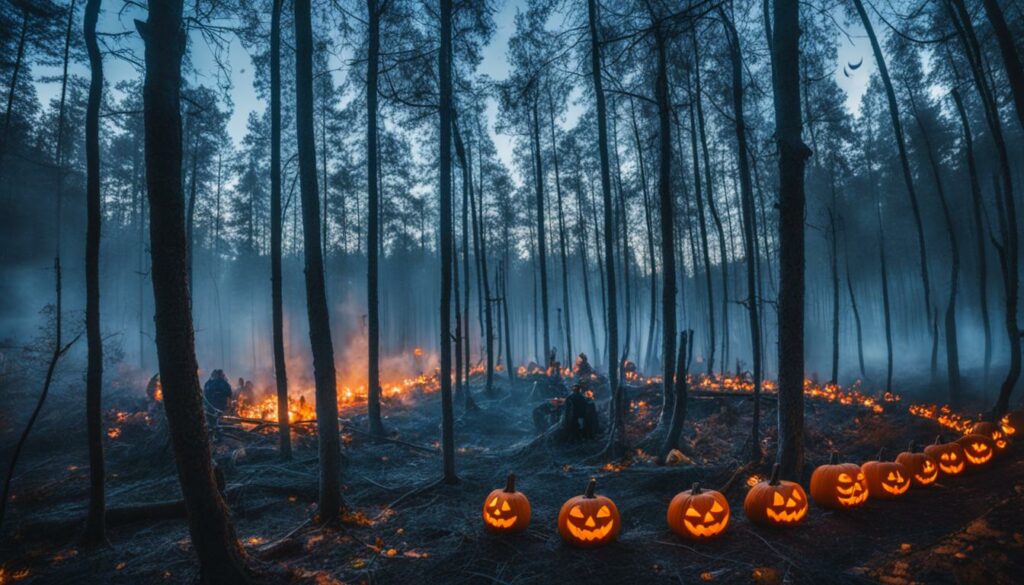
These Halloween events in bars and clubs provide a fun and vibrant atmosphere for those looking to celebrate the holiday in Estonia. Whether you’re a local or a traveler seeking a lively Halloween experience, the bars and clubs in Estonia ensure a memorable and festive celebration.
Quotes:
“We wanted to bring the Halloween spirit to Estonia and create a space where people can have a great time dressing up and enjoying the festive atmosphere,” said Paul Johnson, owner of Red Emperor’s Hostel Bar.
“Club Münt’s Halloween parties are always a hit among our customers. It’s a fantastic opportunity for everyone to express their creativity and immerse themselves in the Halloween spirit,” said Laura Andersson, manager of Club Münt.
Estonian Autumn Holidays – Mardipäev and Kadripäev
In Estonia, the autumn season is marked by two significant holidays – Mardipäev and Kadripäev. These celebrations showcase the rich traditions and cultural heritage of the Estonian people.
Mardipäev: A Festive Harvest Tradition
Mardipäev, also known as Martinmas, takes place on November 10th. It is a day when children in the village embark on a delightful adventure, visiting houses in colorful costumes, singing traditional songs, and entertaining residents with riddles. In return for their performances, the children are rewarded with sweets and treats. This lively tradition is believed to bring good fortune and prosperity to the harvest season in Estonia.
Kadripäev: Honoring Women and Welcoming Winter
Kadripäev, celebrated on November 25th, marks the transition from autumn to winter and has a special focus on women. During this holiday, children dress up and go door-to-door, singing enchanting songs and receiving treats in a manner reminiscent of other autumn festivities. This tradition not only brings joy and excitement but also symbolizes the importance of women in Estonian culture and their role in the changing seasons.
“Mardipäev and Kadripäev are cherished autumn holidays in Estonia, embodying the spirit of community, gratitude, and the passing of seasons. They reflect the close connection between nature, harvests, and the rural way of life.”
These traditional autumn holidays continue to be celebrated in some communities in Estonia, preserving the country’s cultural heritage and reinforcing the importance of collective rituals and customs. While Estonia may have its unique way of embracing the autumn season, it also welcomes influences from abroad, including the adoption of Western Halloween traditions in bars and clubs.
To provide a visual representation of Estonian autumn traditions, here’s an image showcasing the vibrant costumes and joyous celebrations of Mardipäev and Kadripäev:
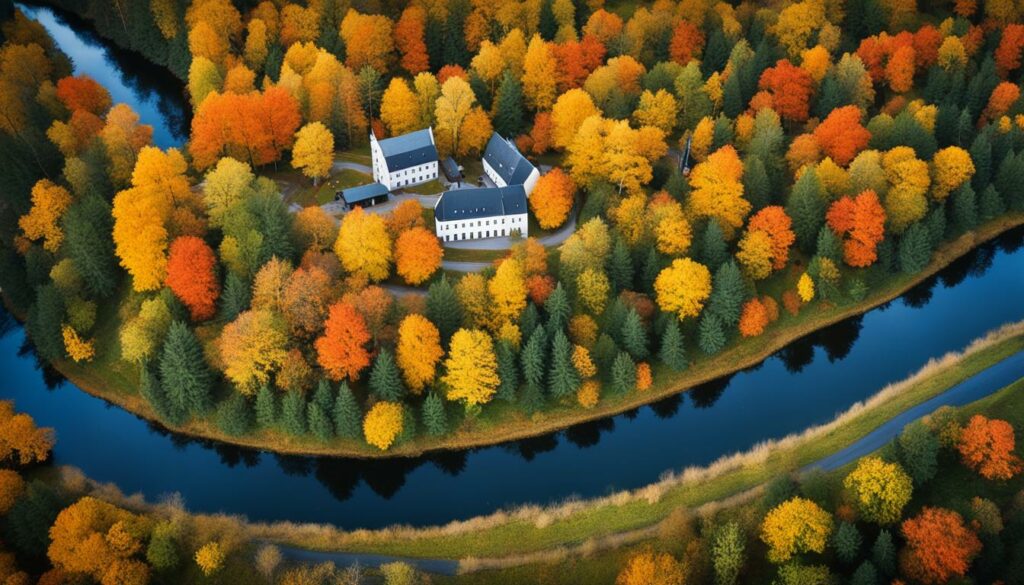
| Autumn Holidays | Date | Key Features |
|---|---|---|
| Mardipäev | November 10th | Children sing, tell riddles, and collect sweets |
| Kadripäev | November 25th | Children dress up, sing songs, and receive treats |
Estonian autumn holidays, Mardipäev and Kadripäev, offer a unique glimpse into the rich cultural heritage and traditions of the Estonian people. These celebrations serve as a reminder of the importance of community, gratitude, and the interconnectedness of nature and seasons.
Origins of Estonia’s Autumn Holidays
The autumn holidays in Estonia, including Mardipäev and Kadripäev, have their roots in the rural traditions of the country. These holidays take place during the time when harvests are ending, and the days are growing shorter. They are associated with the visiting of departed souls and rituals for good luck. The end of harvests and agricultural activity coincides with the darkest part of the year and the beginning of winter. It was believed that pleasing the visiting souls would ensure protection for crops, sheep, and cattle. Offering food and engaging in customs like singing and riddling were important parts of these traditions.
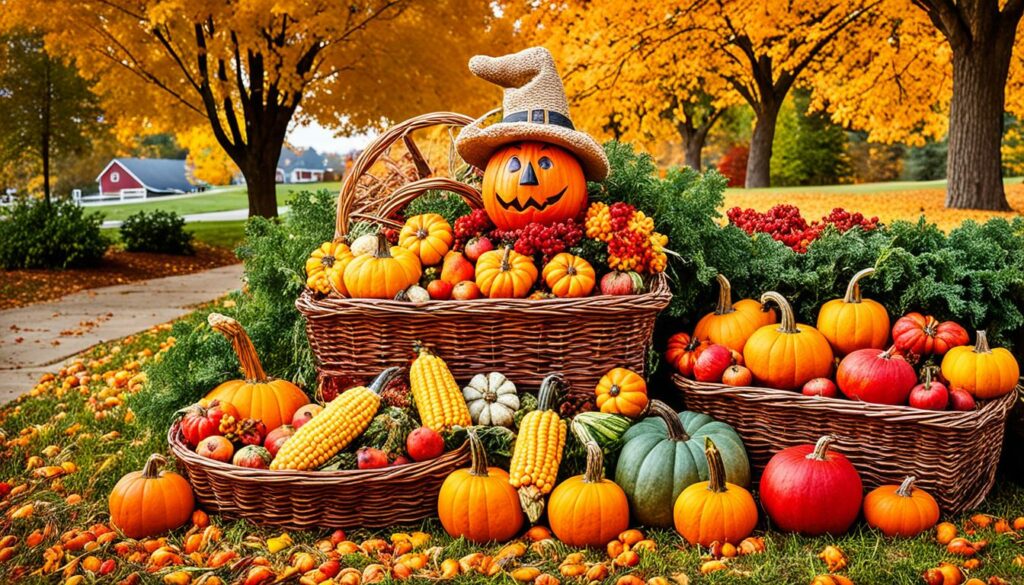
As the bountiful autumn harvests came to an end in Estonia, the locals believed that the spirits of departed loved ones and ancestors would visit their homes. They sought to honor these spirits and ensure their protection for the coming year. Through rituals and customs, they established a connection between the natural cycle of harvests and the spiritual realm.
The traditions surrounding Mardipäev and Kadripäev reflect the agricultural lifestyle and close-knit communities of rural Estonia. These holidays were a way for people to express their gratitude for the successful harvests and seek good luck for the next year’s crop and livestock. The rituals also served as a reminder of the interconnectedness between the living and the departed souls.
Harvest Celebrations
During Mardipäev and Kadripäev, families and communities would gather together to celebrate the end of the harvest season. One of the key customs was the offering of food. People would prepare traditional dishes using the fruits of their labor, such as potatoes, grains, and seasonal vegetables.
The celebration of Mardipäev typically involved a village procession led by a mardi-father, dressed in dark clothing. The children would march alongside, making noise and playing instruments to bring good luck to the harvest. A strong sense of community permeated these celebrations as everyone came together to ensure a prosperous year ahead.
Kadripäev, on the other hand, had a special focus on women. The children would be led by a kadri-mother and dressed in light-colored women’s clothing. Traditional food like kama, porridge, beans, and peas would be shared amongst the celebrants, along with homemade beer. This holiday symbolized the transition from autumn to winter and the importance of women’s roles in nurturing and protecting the cattle.
Honoring Departed Souls
The autumn holidays in Estonia also held a spiritual significance. It was believed that during this time, the spirits of departed loved ones and ancestors would visit their homes. To honor these souls and ensure their continued protection, Estonians would engage in various rituals and customs.
One such ritual was the lighting of candles. Estonians would place candles in windows or on graves to guide the visiting spirits and keep them safe on their journey. This beautiful tradition created a serene and ethereal atmosphere, especially in cemeteries on the night of All Souls’ Day.
Other customs included singing songs, telling riddles, and engaging in activities that would entertain the departed souls. It was believed that by pleasing them with music, laughter, and food, the spirits would bring good luck and prosperity to the harvest, livestock, and overall well-being of the community.
| Holiday | Origin |
|---|---|
| Mardipäev | Derived from the Feast of St. Martin and associated with end-of-harvest celebrations |
| Kadripäev | Combination of pre-Christian and Christian traditions, honoring the transition from autumn to winter and the role of women in protecting cattle |
These autumn holidays in Estonia are a testament to the country’s rich cultural heritage and deep connection to the land. Today, while Estonia has developed into a modern society, these traditions continue to be celebrated, especially in smaller towns and rural areas. They serve as a reminder of the importance of harvests, community, and connecting with departed souls in Estonian culture.
Traditional Customs of Mardipäev
On Mardipäev, a traditional autumn holiday celebrated in Estonia, children actively participate in a lively procession led by a mardi-father. Dressed in dark clothing, the mardi-father plays a significant role in this festive event, guiding the children through the community while engaging in customs that bring about good luck for the harvest.
The procession itself is a vibrant spectacle, filled with joyous noise as the children play various instruments or enthusiastically bang pots and pans along the way. Their arrival at each house is believed to bring blessings and good fortune for the upcoming harvest season, emphasizing the strong agricultural ties within Estonian culture.
Following the procession, the community often gathers for a village party, where the spirit of Mardipäev continues to thrive. As part of this celebration, goose meat is traditionally served, symbolizing further prosperity and luck for the harvest. This communal gathering not only strengthens the bond among neighbors but also serves as a reminder of the importance of shared traditions and the spirit of unity within Estonian society.
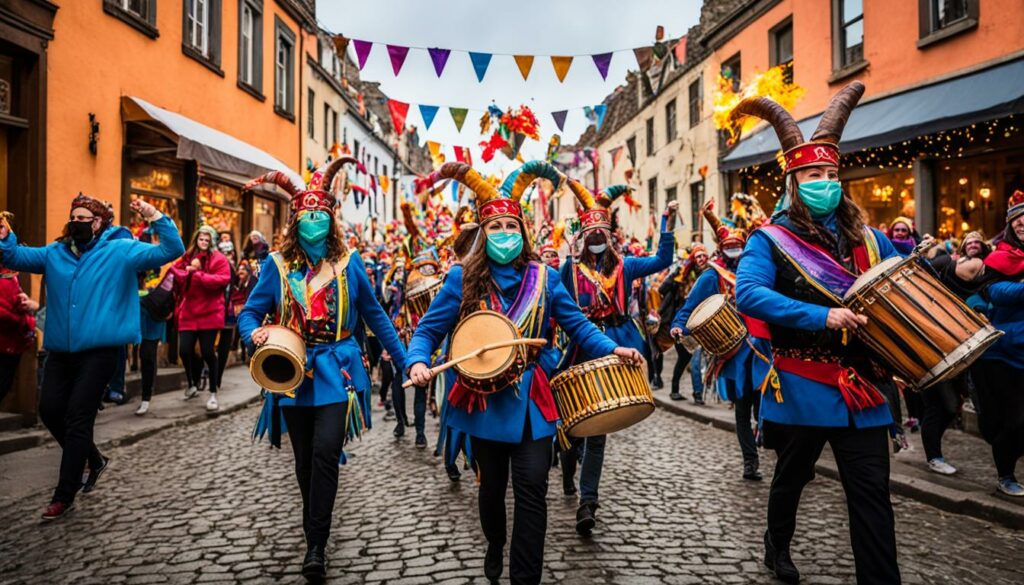
| Mardipäev Procession | Traditional Customs and Symbolism |
|---|---|
| The procession led by a mardi-father and accompanied by children dressed in festive attire. | Emphasizes the significance of community involvement and coming together to celebrate. |
| Noise-making using instruments and pots and pans along the procession route. | Believed to chase away evil spirits and bring luck for a bountiful harvest. |
| Gatherings and village parties following the procession. | Provide an opportunity for the community to connect, share their blessings, and enjoy the festive atmosphere. |
| Feasting on goose meat during the village party. | Serves as both a symbolic and practical gesture to ensure prosperity and good fortune for the upcoming harvest. |
These traditional customs of Mardipäev continue to be cherished in Estonia, serving as a testament to the rich cultural heritage and the deep-rooted connection between the community, nature, and the bounty of the harvest.
Kadripäev – A Celebration of Women and Animals
Kadripäev is a holiday in Estonia that celebrates the transition from autumn to winter and pays homage to women and animals. This traditional Estonian festival holds great cultural significance and is observed with various customs and rituals.
On Kadripäev, children play a central role in the celebrations. Led by a kadri-mother, they dress in light-colored women’s clothing, symbolizing the connection between women and the changing seasons. This attire adds a touch of whimsy and creates a visual spectacle during the festivities.
Traditional food is an essential part of Kadripäev. Special dishes like kama (a traditional Estonian flour blend), porridge, beans, and peas are prepared and shared among family and friends. The flavors and aromas of these dishes evoke a sense of warmth and comfort, enhancing the festive ambiance.
Homemade beer is also enjoyed during Kadripäev. This traditional drink adds a lively and convivial element to the celebrations, allowing participants to raise a glass and toast to the season’s transition.
Kadripäev is not only a celebration of women but also a time to acknowledge the importance of animals during the winter months. It is believed that Kadri, the guardian spirit of cattle, brings luck and protection to cows and sheep as they face the challenges of the cold season. This connection between women, animals, and winter further reinforces the deep-rooted folklore and traditions associated with Kadripäev.
The Kadripäev celebrations in Estonia highlight the harmony between nature, women, and the changing seasons. It is a time to come together, honor traditions, and appreciate the interconnectedness of all living beings.
To commemorate Kadripäev, communities in Estonia organize various activities and events. These may include music performances, dance exhibitions, craft fairs, and storytelling sessions, all of which contribute to the festive atmosphere and showcase the rich cultural heritage of the country.

| Kadripäev Traditions | Description |
|---|---|
| Kadri-mother Procession | Children dress as kadri-mothers and lead the festivities, symbolizing the connection between women and the changing seasons. |
| Traditional Food | Kama, porridge, beans, and peas are enjoyed during Kadripäev, adding a taste of tradition to the celebrations. |
| Homemade Beer | Locally brewed beer is shared among family and friends, adding a cheerful element to the festive mood. |
| Animal Blessings | Kadripäev celebrates the role of women and their connection to animals, particularly cows and sheep, offering them luck and protection during the winter months. |
Modern Celebrations of Autumn Holidays in Estonia
While modern-day Estonia is no longer primarily an agricultural society, the autumn holidays of Mardipäev and Kadripäev are still celebrated, especially in small towns and the countryside. These traditional customs hold a special place in Estonian culture and continue to be cherished by the locals.
During Mardipäev, which takes place on November 10th, school children enthusiastically dress up in costumes and partake in a procession led by a mardi-father. Making noise with instruments and banging pots, they visit each house, bringing good luck and blessings for the harvest. The festivities then culminate in a village party where goose meat is served, symbolizing further fortune for the agricultural season.
Kadripäev, celebrated on November 25th, is a vibrant holiday that focuses on women and heralds the end of autumn and the arrival of winter. Children accompany a kadri-mother as they go door-to-door in their light-colored women’s clothing, singing songs and spreading joy. Traditional foods like kama, porridge, beans, and peas are enjoyed along with homemade beer, encapsulating the spirit of celebration and camaraderie.
These autumn holidays serve as a reminder of Estonia’s rich cultural heritage and the deep connection between its people and the changing seasons. The modern celebrations of Mardipäev and Kadripäev keep these cherished traditions alive, not only in the hearts of Estonians but also through special events held at the Open Air Museum in Tallinn.
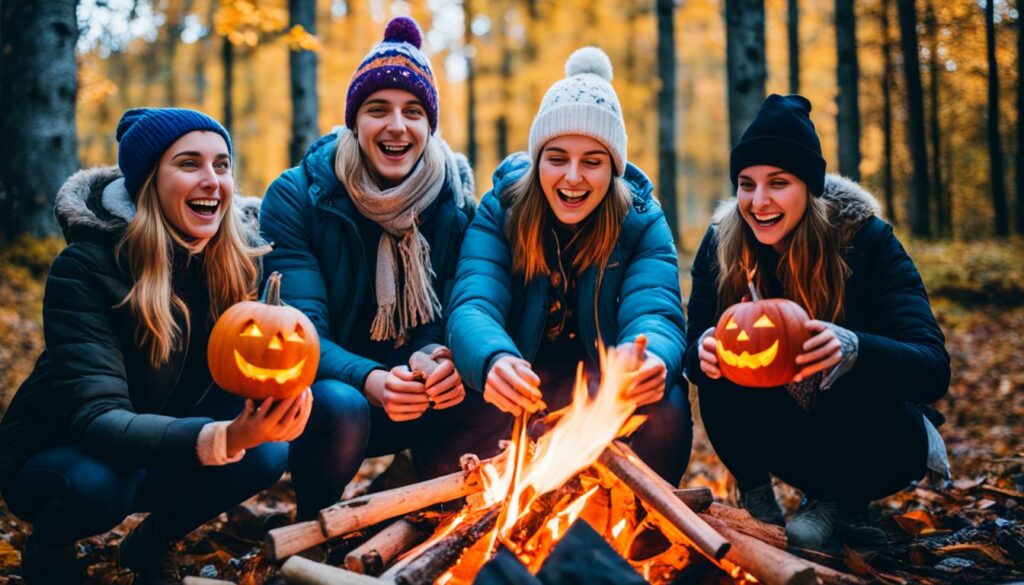
At the Open Air Museum, visitors can immerse themselves in an authentic Estonian experience, witnessing traditional customs, dances, and songs associated with these autumn holidays. The museum provides a unique opportunity to explore Estonian history and enjoy firsthand the vibrant spirit and cultural significance of Mardipäev and Kadripäev.
Estonian Autumn Holiday Celebrations at the Open Air Museum:
| Festival | Date | Description |
|---|---|---|
| Mardipäev | November 10th | A day filled with lively parades, traditional costumes, music, dancing, and delicious local food. |
| Kadripäev | November 25th | Celebrating women and the coming winter with singing, dancing, and enjoying traditional Estonian cuisine. |
Visiting the Open Air Museum during these autumn holidays provides a unique opportunity to witness and engage in the vibrant celebrations cherished by the Estonian community. It’s a chance to gain insight into the country’s rich cultural heritage and the important role that these traditional customs play in Estonian society.
Halloween Traditions in Ireland – The Birthplace of Halloween
Ireland holds a significant place in the history of Halloween as the birthplace of the festival. The roots of Halloween can be traced back to the ancient Celtic festival of Samhain, which marked the end of summer and the beginning of winter. Samhain was a time when the boundary between the living and the dead was believed to be blurred, and it was celebrated with various rituals and customs.
One of the most iconic Halloween traditions in Ireland is the lighting of bonfires. These bonfires were lit to ward off evil spirits and provide warmth and light during the dark winter nights. Communities would gather around the bonfires, sharing stories and participating in festivities.
Another cherished tradition in Ireland is the sharing of Barnbrack, a special fruitcake. Barnbrack is baked with various objects hidden inside, each with a specific meaning. For example, finding a ring means marriage is in the future, while finding a coin signifies wealth. This fun tradition adds an element of excitement and anticipation to Halloween celebrations in Ireland.
“Halloween in Ireland is steeped in ancient folklore and traditional customs. From the lighting of bonfires to the sharing of Barnbrack, the festivities bring communities together to honor their heritage and connect with the spirits of the past.”
Additionally, serving Colcannon for dinner is a common Halloween custom in Ireland. Colcannon is a dish made from mashed potatoes and cabbage or kale, with hidden coins concealed within the potatoes. Finding a coin while eating Colcannon is believed to bring good luck and prosperity in the coming year.
Lastly, the practice of putting Ivy Leaves in water is another unique Halloween tradition in Ireland. Ivy Leaves were placed in water on Halloween night, and the appearance of the leaves the following day would supposedly reveal the health of individuals in the upcoming year. This tradition reflects the deep connection between nature and folklore in Irish culture.

Irish Halloween Traditions:
- Lighting bonfires to ward off evil spirits
- Sharing Barnbrack, a fruitcake with hidden objects
- Serving Colcannon for dinner
- Putting Ivy Leaves in water to determine health
Halloween in Ireland is a rich tapestry of ancient traditions and folklore that brings communities together to celebrate their heritage. The customs of bonfires, Barnbrack, Colcannon, and Ivy Leaves reflect the deep connection between Ireland’s past and present, making Halloween a truly enchanting and unforgettable time of the year in the Emerald Isle.
Halloween Customs from Around the World
Halloween is celebrated all over the world, and each country has its own unique customs and traditions associated with the holiday. From Austria to Poland, let’s explore some fascinating Halloween customs from around the globe.
Austria
In Austria, it is believed that welcoming the souls of the departed is important. People place bread, water, and a lamp on the table to ensure a warm reception for these spirits.
Belgium
In Belgium, encountering a black cat is considered bad luck during Halloween. Belgians believe that if a black cat crosses your path, misfortune may follow.
China
In China, the Feast of the Hungry Ghosts is observed during Halloween. This festival is dedicated to honoring restless spirits through various rituals and offerings.
Czechoslovakia
Czechoslovakia celebrates Halloween with customs like placing chairs by the fireplace to welcome the spirits. This gesture ensures that departed loved ones have a comfortable place to rest.
England
In England, Halloween is celebrated with various traditional customs. One popular activity is “dooking” for apples, where individuals try to bite an apple out of a basin of water using only their mouths.
France
French Halloween celebrations often involve baking and enjoying delicious treats like “soul cakes.” These small round cakes are traditionally offered to visitors or given to the less fortunate.
Germany
Germany celebrates Halloween with a unique tradition called Rübengeistern. During this custom, people carve turnips into lanterns to ward off evil spirits.
Japan
In Japan, Halloween is gaining popularity through various events and parties. The festival includes costume contests, themed decorations, and parades.
Mexico
Mexico celebrates Halloween alongside the Day of the Dead, known as Dia de los Muertos. This vibrant and colorful holiday honors deceased loved ones with colorful altars, marigold flowers, and visits to cemeteries.
Philippines
Halloween in the Philippines is celebrated with a mix of local customs and Western traditions. Filipinos light candles in cemeteries and offer prayers for their departed relatives.
Poland
In Poland, Halloween is known as “Noce Świętojańskie” (St. John’s Eve). People celebrate with bonfires, concerts, and traditional dances to ward off evil spirits.
As we can see, Halloween customs vary greatly around the world, showcasing each country’s unique cultural traditions and beliefs. From welcoming departed souls in Austria to lighting bonfires in Poland, these customs add depth and diversity to the celebration of Halloween on a global scale.

Halloween Celebrations in Hong Kong, Belgium, and the Philippines
While Halloween is celebrated in various ways around the world, each country has its own unique customs and traditions. Let’s explore how Halloween is celebrated in Hong Kong, Belgium, and the Philippines.
Halloween Celebrations in Hong Kong
In Hong Kong, the Yul Lan festival is celebrated as a way to honor and remember ancestors and departed loved ones. It is believed that during this time, the spirits of the deceased visit the world of the living. To connect with these spirits, people burn pictures of fruit and money as offerings, hoping that they will reach the afterlife. This festival is an important time for families to remember and pay tribute to their ancestors.
Halloween Celebrations in Belgium
In Belgium, Halloween is celebrated in a more solemn way. It is a time to remember and honor loved ones who have passed away. Lighting candles in remembrance of the deceased is a common tradition, illuminating cemeteries and creating a peaceful and reflective atmosphere. Families visit the graves of their loved ones, tidying the burial sites and leaving flowers and other offerings. The emphasis during Halloween in Belgium is on commemorating the lives of those who are no longer with us.
Halloween Celebrations in the Philippines
In the Philippines, Halloween is a significant holiday known as “Undas” or “Araw ng mga Patay” (Day of the Dead). It is a time when families gather to remember and honor their deceased relatives. Graveyards are adorned with candles, flowers, and colorful decorations. People often spend the night beside the graves, praying and reminiscing about their loved ones. Lighting candles is a meaningful gesture of respect and remembrance during this time of reflection and connection with departed family members.
Each country we’ve explored – Hong Kong, Belgium, and the Philippines – has its own unique way of celebrating Halloween and remembering those who have passed. From burning offerings to lighting candles, these customs demonstrate the cultural diversity and rich traditions associated with Halloween across the globe.
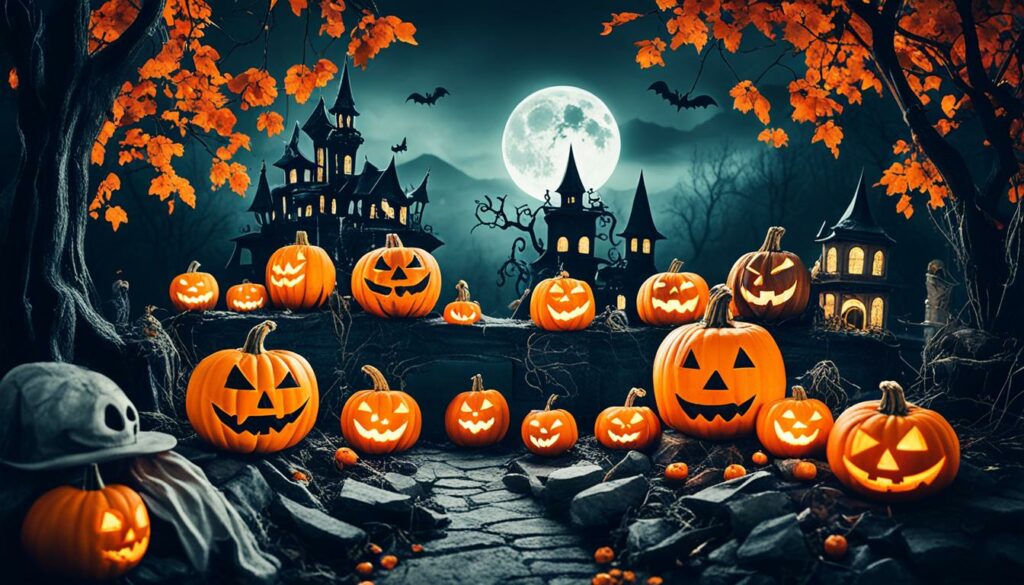
| Country | Customs |
|---|---|
| Hong Kong | The Yul Lan festival is celebrated. People burn pictures of fruit and money as offerings to reach the spirits in the afterlife. |
| Belgium | Lighting candles in memory of loved ones is a common Halloween tradition. |
| Philippines | People light candles to honor their deceased relatives during the Day of the Dead. |
Conclusion
While Estonia does not traditionally celebrate Halloween, the country has its own autumn traditions that are deeply rooted in Estonian folklore and customs. All Souls’ Day, Mardipäev, and Kadripäev are important holidays that reflect the connection between the seasons, harvests, and the honoring of departed loved ones.
During All Souls’ Day, Estonians place candles in windows or on graves as a solemn way to remember their deceased relatives. Mardipäev and Kadripäev are unique celebrations that involve processions, dressing up, and singing songs. These holidays highlight the importance of community and maintaining cultural traditions.
Although Halloween customs have made their way to Estonia, they are primarily observed in bars and clubs, offering opportunities for people to dress up and enjoy Halloween-themed events. Despite not having a strong Halloween tradition, Estonia embraces its own unique celebrations and customs during the autumn season, showcasing the country’s rich cultural heritage.

